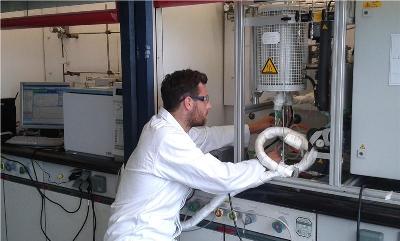A team of researchers has developed an innovative method for harnessing the power of CO2 to produce methanol. Methanol is an environmentally friendly fuel and can be used instead of gasoline.
 Doctoral candidate Elias Frei controls the temperature in the reactor of the catalyst test device. Source: FMF
Doctoral candidate Elias Frei controls the temperature in the reactor of the catalyst test device. Source: FMF
Prof. Dr. Ingo Krossing led the team at the Freiburg Materials Research Center (FMF). They aim to harness and integrate the power of CO2 for production of energy on a large scale. They combined hydrogen and CO2 to produce methanol. They used the hydrogenolysis process and in a high pressure environment they combined the two gases.
Methanol may be used to power fuel cells as they can store hydrogen chemically. It is a sustainable method of storage and it holds great potential for energy storage. When compared to conventional fuels it is less harmful and dangerous to the environment.
The FMF team aims to develop new methods and catalysts to speed up the chemical reaction. For catalysts, they employed metal oxides such as zirconium dioxide, zinc and copper. This allowed the reaction to take place at temperatures lower than conventional temperatures. When nanoparticles were used in the catalysts they displayed better activity.
The researchers tested using ionic liquids with the catalysts. These liquids are salts that are in a liquid state. The ionic liquids were impregnated into catalysts where they cover the catalysts in the form of a thin film. This fixes hydrogen and CO2 to the catalyst. Water and methanol are removed, and this methanol can be used as fuel.
Using this novel technique, the researchers aim to produce methanol in large quantities. CO2 will be drawn from the waste gas emitted from combined heat and power plants and used for methanol production. According to the theory, 50% less CO2 can be used to produce the same energy, because CO2 gets released when methane is burned. According to the researchers, the annual fuel requirements of Germany could be met through harnessing 10% of its annual CO2 emissions.